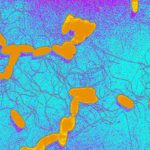Lien vers Pubmed [PMID] – 22682545
Int. J. Food Microbiol. 2012 Jul;157(2):189-94
During two surveys conducted in 2008 and 2009, the culture method described in the international standard ISO/TS 21872-1 was applied to the detection of Vibrio parahaemolyticus and Vibrio cholerae in 112 living bivalve mollusc samples, with a chromogenic medium used in addition to the TCBS agar, as second selective isolation medium and for enumeration of V. parahaemolyticus and V. cholerae by surface inoculation. A PCR method for detection of these 2 Vibrio species and the hemolysin genes tdh and trh, was applied in parallel. In 2009, the survey was extended to finfish fillets and crustaceans. PCR was also used for species confirmation of characteristic colonies. The identity of the PCR products, specifically targeting V. parahaemolyticus, was checked by sequencing. Occurrence of V. parahaemolyticus and V. cholerae isolates in living bivalve molluscs ranged from 30.4% to 32.6% and from 1.4% to 4.7% respectively. In frozen crustaceans (2009 survey) V. parahaemolyticus and V. cholerae isolates were respectively found in 45% and 10% of the samples. No V. parahaemolyticus or V. cholerae was detected in frozen fish fillets, neither by the ISO method nor by PCR. In 2009, enteropathogenic V. parahaemolyticus (trh+) was isolated from 4 out of 43 oyster samples while the trh gene was present in V. alginolyticus strains and in samples where V. parahaemolyticus was not detected (9 over 112 samples). The ISO method failed to isolate V. parahaemolyticus in 44% to 53% of the living bivalve molluscs where PCR detected the toxR gene specific of V. parahaemolyticus (Vp-toxR). Our results highlighted the need for a revision of the ISO/TS 21872-1 standard, at least, for analysis of living bivalve molluscs, and confirmed the increasing concern of enteropathogenic V. parahaemolyticus in French bivalve molluscs. Enrichment at 41.5°C was questioned and some reliable solutions for the improvement of the ISO/TS 21872-1 method, such as the PCR method for screening of positive samples and confirmation of colonies, were pointed out.
